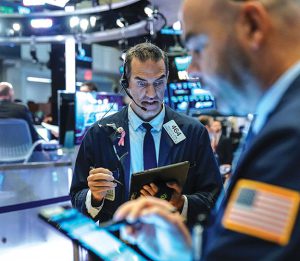Bloomberg
US equity-index futures rise and the dollar fell as risk-taking returned to markets at the end of a turbulent week, with investors weighing US employment gains against the Federal Reserve’s policy-tightening plans.
March contracts on the technology-heavy Nasdaq 100 Index advanced 0.2%, after falling as much as 0.6%. S&P 500 futures also climbed 0.2%. Europe’s Stoxx 600 index was on course for a weekly loss. US Treasuries were steady, with the two-year yield heading for the biggest weekly spike since October 2019. The euro strengthened as record inflation raised the prospect of a hawkish tilt at the European Central Bank.
US hiring may have more than doubled in December from the previous month to 447,000 new jobs, projections for nonfarm payrolls show. The release would follow the ADP Research Institute data that showed companies added the most positions in seven months. With Fed officials preparing for aggressive rate hikes and a contraction of the central bank’s balance sheet, markets expect little chance of a change of heart even if Friday’s figures come in below expectations.
An overtly hawkish stance from the Fed has roiled financial markets at the start of a new year, with investors reassessing how to price assets in an environment of rising interest rates. The removal of crisis-era accommodation marks a shift not seen in at least three years, a time that also saw a spike in volatility.
Comments by regional Fed presidents provided some additional insight Thursday as traders attempted to predict a possible schedule for tightening. St. Louis Fed President James Bullard, a more hawkish policy maker, said in a speech the central bank could raise its target interest rate as soon as March. Meanwhile, San Francisco Fed President Mary Daly said at a virtual event that trimming the Fed balance sheet would come after normalising the Fed funds rate.
Europe’s equity benchmark fell 0.2% on Friday as travel and real estate companies posted some of the biggest losses. Stocks in the region have had a bumpy first week of the year, with the gauge posting back-to-back losses following three consecutive record highs. In addition to watching the Fed, investors are monitoring Covid-19 developments, with Germany poised to tighten restrictions on access to restaurants and cafes.
Consumer prices in the euro area jumped 5% from a year earlier in December, adding pressure on the ECB to join a growing legion of central banks from the Fed to the Bank of England in tightening monetary conditions. The euro rose 0.2% against the greenback.
Oil climbed to a seven-week high on supply constraints. Gains in commodities and emerging-market stocks further underscored the Friday rebound in risk sentiment.
 The Gulf Time Newspaper One of the finest business newspapers in the UAE brought to you by our professional writers and editors.
The Gulf Time Newspaper One of the finest business newspapers in the UAE brought to you by our professional writers and editors.
